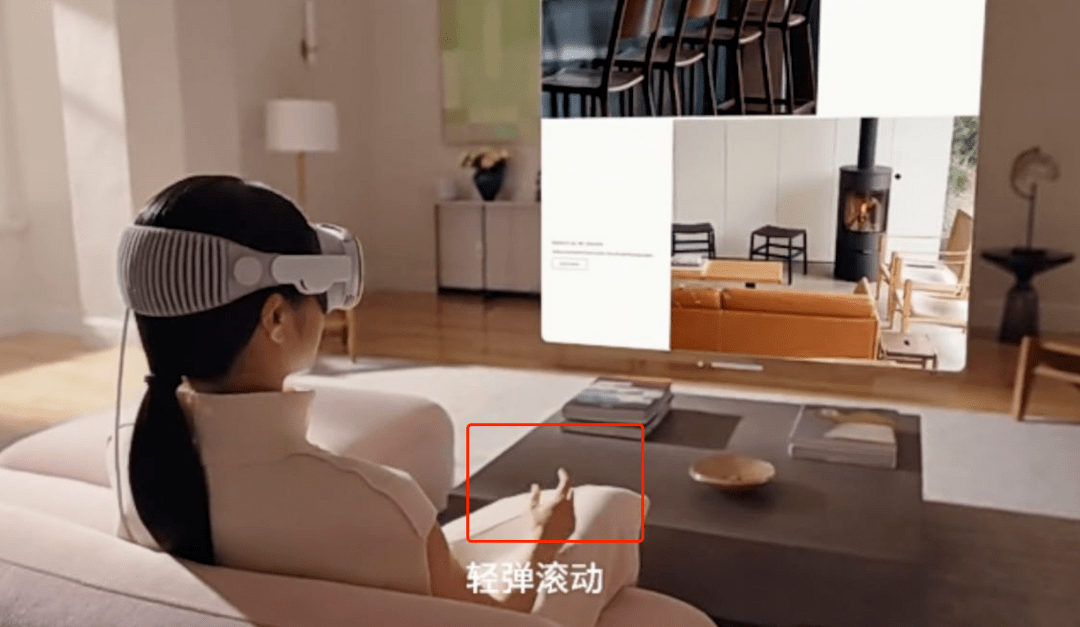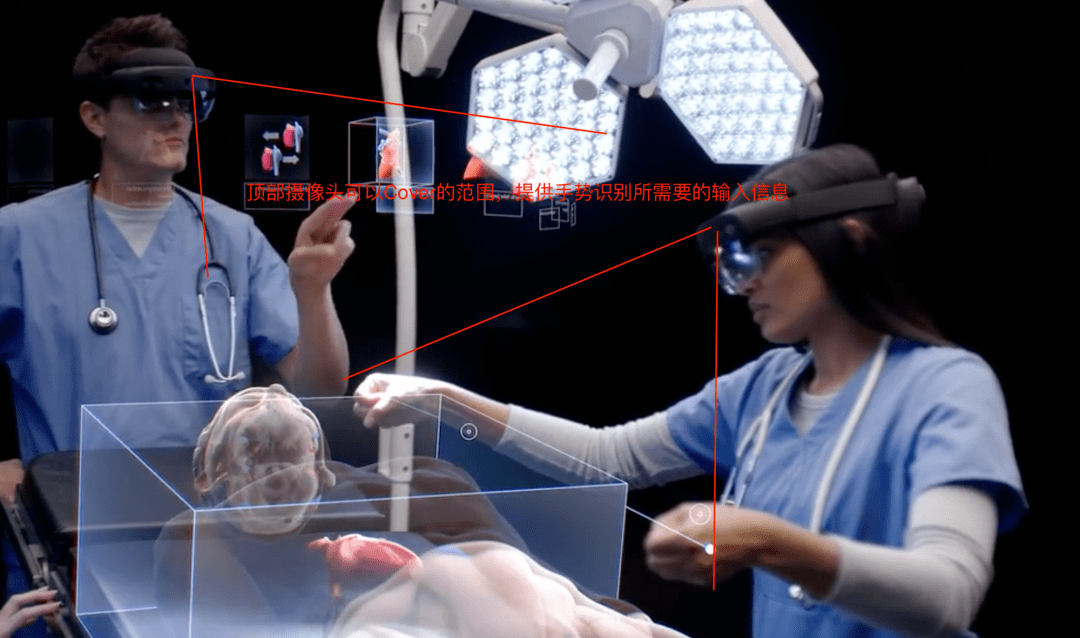Three key technologies give AR interfaces the power
This article will start from a technical perspective and take the recently launched Apple MR as an example to analyze the three key technical points that the AR world needs to rely on: eye tracking, manual recognition and spatial calculation. Let’s take a look at the author’s analysis of these three technical points~

In the physical world, observing with eyes and operating with hands are the most natural ways of interaction. To realize the continuation of this natural interaction in the AR world, we need to rely on three key technical points.
We are not disappointed, as the release of Apple Vision Pro demonstrates the natural interaction capabilities enabled by three technologies.
1. Eye tracking technology
If we need to interact further with an object in reality, we will naturally focus our eyes on it. When we spend our attention to focus our eyes on it, it already represents our choice.
This process covers two states in the current interface field: activation state (focus) and click state (selection). Eye tracking technology realizes the process of seeing and focusing.
This technology is certainly not the first of its kind. The pioneer of AR glasses, Microsoft Holoens 2nd generation interaction features Eye-gaze, which is the function of focusing with your eyes.
Previously, the head-gaze interaction of the first generation of Microsoft Holoens actually had the concept of seeing and activating with the eyes. However, in Head-gaze, the head is slightly moved to control a point (Gaze) in the center of the screen to activate content. There is always a gap between it and our original natural interaction, because in fact, we focus on an object and do not need to focus on it every time. Just rely on your head to move and your eyes to move.
However, although eye tracking technology can better solve the standard of natural interaction, head-motion interaction is not without its merits. For example, the glasses currently developed by my team can only support head-gaze interaction. The cost and technical difficulty of this interactive method are lower. Compared with the focus activation method by hand/mouse/remote control, etc., it is closer to the natural interaction concept of seeing with our eyes.
In addition, eye tracking technology has realized the activation state, but it has not yet truly realized the selection, that is, the click state. The function is to tell the machine that I confirm it is it.
In strict terms, it is very necessary to omit the manual confirmation step for things that do not require operation. For example, when I am eating snacks and watching TV shows, I really hope that I don’t have to wipe my dirty hands before every operation... In the manufacturing field, this kind of need to free up hands is often raised by customers.
For more natural interaction, maybe this can also become part of our imagination. I wrote about a patent before that relied on brainwave technology for simple confirmation.
2. Gesture recognition technology
Eye tracking satisfies the interaction of viewing this part with eyes, while operating with hands requires gesture recognition technology.
This is not a new technology. It has been installed on many ARVR devices before. Of course, the degree of implementation needs to be confirmed by actual experience.
In the promotional video of Vision Pro, the gesture recognition looks very natural, and the hand does not even need to be raised. This should rely on 4 sets of downward-view cameras (this is probably one of the reasons why a 12-camera configuration is required).

Compared with the promotional video of Hololens2, it can be seen that the gesture is covered by the overhead camera.

Because gesture recognition relies on the camera (the computer needs input to know how your hands are moving), the results of the same gesture taken from different angles will be different, and the recognition results will also be affected.
In addition, the experience of 2D gesture recognition and 3D gesture recognition technology is also different.
3. Spatial calculation
To make it easier for the eyes to see and more natural to operate with the hands, the device needs to have the ability to understand space. Spatial computing is what Vision Pro wants to promote. Their emphasis on this capability makes them believe that this capability can divide an era.
"Spatial Computing Era".
Many interactions occur naturally because the machine has spatial computing capabilities. In other words, if the machine does not have the ability to understand space, these interactions cannot occur naturally. Nerf, SLAM, 3DOF, and 6DOF are all part of spatial computing technology, and everything you hear falls into this category.
From an experience perspective, the perception of distance between objects and between objects and users brought about by spatial depth; changes in the shape of objects brought about by the user's perspective orientation in different positions and postures; factors in the real environment Changes in color perception caused by differences in light such as time and weather; or even sounds from different spatial locations, etc. Spatial computing can give designers more space for natural interaction.
It can be said that spatial computing is the key technology that will enable AR to become different from ordinary screen interfaces in the future, and what we really expect, "everything you look at can become an interface."
Columnist
Lin Yingluo, WeChat public account: There are shadows falling in the forest, and everyone is a product manager columnist. A user experience designer who knows how to play cards, author of "AR Interface Design", 10 years of UIUX design experience, focusing on user experience design in the field of AR and intelligence for 6 years; design & psychology education background, national professional certification advanced OH card Teacher/Talent Discovery Coach. I hope my efforts can add value to the design field of an intelligent future and make the designer's career more valuable
Title picture comes from Unsplash, based on CC0 protocol
The above is the detailed content of Three key technologies give AR interfaces the power. For more information, please follow other related articles on the PHP Chinese website!

Hot AI Tools

Undresser.AI Undress
AI-powered app for creating realistic nude photos

AI Clothes Remover
Online AI tool for removing clothes from photos.

Undress AI Tool
Undress images for free

Clothoff.io
AI clothes remover

Video Face Swap
Swap faces in any video effortlessly with our completely free AI face swap tool!

Hot Article

Hot Tools

Notepad++7.3.1
Easy-to-use and free code editor

SublimeText3 Chinese version
Chinese version, very easy to use

Zend Studio 13.0.1
Powerful PHP integrated development environment

Dreamweaver CS6
Visual web development tools

SublimeText3 Mac version
God-level code editing software (SublimeText3)

Hot Topics
 Huawei's official introductory tutorial for Cangjie programming language is released. Learn how to obtain the universal version SDK in one article
Jun 25, 2024 am 08:05 AM
Huawei's official introductory tutorial for Cangjie programming language is released. Learn how to obtain the universal version SDK in one article
Jun 25, 2024 am 08:05 AM
According to news from this site on June 24, at the keynote speech of the HDC2024 Huawei Developer Conference on June 21, Gong Ti, President of Huawei Terminal BG Software Department, officially announced Huawei’s self-developed Cangjie programming language. This language has been developed for 5 years and is now available for developer preview. Huawei's official developer website has now launched the official introductory tutorial video of Cangjie programming language to facilitate developers to get started and understand it. This tutorial will take users to experience Cangjie, learn Cangjie, and apply Cangjie, including using Cangjie language to estimate pi, calculate the stem and branch rules for each month of 2024, see N ways of expressing binary trees in Cangjie language, and use enumeration types to implement Algebraic calculations, signal system simulation using interfaces and extensions, and new syntax using Cangjie macros, etc. This site has tutorial access address: ht
 After 5 years of research and development, Huawei's next-generation programming language 'Cangjie” has officially launched its preview
Jun 22, 2024 am 09:54 AM
After 5 years of research and development, Huawei's next-generation programming language 'Cangjie” has officially launched its preview
Jun 22, 2024 am 09:54 AM
This site reported on June 21 that at the HDC2024 Huawei Developer Conference this afternoon, Gong Ti, President of Huawei Terminal BG Software Department, officially announced Huawei’s self-developed Cangjie programming language and released a developer preview version of HarmonyOSNEXT Cangjie language. This is the first time Huawei has publicly released the Cangjie programming language. Gong Ti said: "In 2019, the Cangjie programming language project was born at Huawei. After 5 years of R&D accumulation and heavy R&D investment, it finally meets global developers today. Cangjie programming language integrates modern language features, comprehensive compilation optimization and Runtime implementation and out-of-the-box IDE tool chain support create a friendly development experience and excellent program performance for developers. "According to reports, Cangjie programming language is an all-scenario intelligence tool.
 Huawei launches HarmonyOS NEXT Cangjie programming language developer preview beta recruitment
Jun 22, 2024 am 04:07 AM
Huawei launches HarmonyOS NEXT Cangjie programming language developer preview beta recruitment
Jun 22, 2024 am 04:07 AM
According to news from this site on June 21, Huawei’s self-developed Cangjie programming language was officially unveiled today, and the official announced the launch of HarmonyOSNEXT Cangjie language developer preview version Beta recruitment. This upgrade is an early adopter upgrade to the developer preview version, which provides Cangjie language SDK, developer guides and related DevEcoStudio plug-ins for developers to use Cangjie language to develop, debug and run HarmonyOSNext applications. Registration period: June 21, 2024 - October 21, 2024 Application requirements: This HarmonyOSNEXT Cangjie Language Developer Preview Beta recruitment event is only open to the following developers: 1) Real names have been completed in the Huawei Developer Alliance Certification; 2) Complete H
 Tianjin University and Beihang University are deeply involved in Huawei's 'Cangjie” project and launched the first AI agent programming framework 'Cangqiong” based on domestic programming languages.
Jun 23, 2024 am 08:37 AM
Tianjin University and Beihang University are deeply involved in Huawei's 'Cangjie” project and launched the first AI agent programming framework 'Cangqiong” based on domestic programming languages.
Jun 23, 2024 am 08:37 AM
According to news from this site on June 22, Huawei yesterday introduced Huawei’s self-developed programming language-Cangjie to developers around the world. This is the first public appearance of Cangjie programming language. According to inquiries on this site, Tianjin University and Beijing University of Aeronautics and Astronautics were deeply involved in the research and development of Huawei’s “Cangjie”. Tianjin University: Cangjie Programming Language Compiler The software engineering team of the Department of Intelligence and Computing of Tianjin University joined hands with the Huawei Cangjie team to deeply participate in the quality assurance research of the Cangjie programming language compiler. According to reports, the Cangjie compiler is the basic software that is symbiotic with the Cangjie programming language. In the preparatory stage of the Cangjie programming language, a high-quality compiler that matches it became one of the core goals. As the Cangjie programming language evolves, the Cangjie compiler is constantly being upgraded and improved. In the past five years, Tianjin University
 Huawei's self-developed Cangjie programming language official website and development documents are online, integrating into the Hongmeng ecosystem for the first time
Jun 22, 2024 am 03:10 AM
Huawei's self-developed Cangjie programming language official website and development documents are online, integrating into the Hongmeng ecosystem for the first time
Jun 22, 2024 am 03:10 AM
According to news from this site on June 21, before the HDC2024 Huawei Developer Conference, Huawei’s self-developed Cangjie programming language was officially unveiled, and the Cangjie official website is now online. The official website introduction shows that Cangjie programming language is a new generation programming language for all-scenario intelligence, focusing on "native intelligence, natural all-scenarios, high performance, and strong security." Integrate into the Hongmeng ecosystem to provide developers with a good programming experience. The official website attached to this site introduces as follows: Native intelligent programming framework embedded with AgentDSL, organic integration of natural language & programming language; multi-Agent collaboration, simplified symbolic expression, free combination of patterns, supporting the development of various intelligent applications. Innately lightweight and scalable runtime for all scenes, modular layered design, no matter how small the memory is, it can be accommodated; all-scenario domain expansion
 Comparison of the advantages and disadvantages of C++ technology and other modern programming languages
Jun 01, 2024 pm 10:15 PM
Comparison of the advantages and disadvantages of C++ technology and other modern programming languages
Jun 01, 2024 pm 10:15 PM
A comparison of the advantages and disadvantages of C++ with other modern programming languages is: C++ advantages: high performance, low-level control, rich library ecosystem. C++ disadvantages: steep learning curve, manual memory management, limited portability. Python advantages: smooth learning curve, extensive library support, interpreted language. Advantages of Java: platform independent, automatic memory management, wide application. Advantages of JavaScript: essential for front-end development, lightweight, dynamic type.
 What should I do if the Microsoft Edge browser does not display images? - What to do if the Microsoft Edge browser does not display images?
Mar 04, 2024 pm 07:43 PM
What should I do if the Microsoft Edge browser does not display images? - What to do if the Microsoft Edge browser does not display images?
Mar 04, 2024 pm 07:43 PM
Recently, many friends have asked the editor what to do if the Microsoft Edge browser does not display images. Next, let us learn how to solve the problem of Microsoft Edge browser not displaying images. I hope it can help everyone. 1. First click on the lower left corner to start, and right-click on "Microsoft Edge Browser", as shown in the figure below. 2. Then select "More" and click "App Settings", as shown in the figure below. 3. Then scroll down to find "Pictures", as shown in the picture below. 4. Finally, turn on the switch below the picture, as shown in the picture below. The above is all the content that the editor brings to you on what to do if the Microsoft Edge browser does not display pictures. I hope it can be helpful to you.
 Demystifying Golang's bytecode: exploring the essence of its programming language
Feb 26, 2024 pm 02:36 PM
Demystifying Golang's bytecode: exploring the essence of its programming language
Feb 26, 2024 pm 02:36 PM
Golang (also known as Go language) is an open source programming language developed by Google and first released in 2007 to improve the productivity and development efficiency of engineers. Golang aims to simplify the complexity of programming languages and provide efficient execution speed while taking into account ease of use. This article will deeply explore the characteristics of Golang, analyze its bytecode mechanism, and reveal its working principle through specific code examples. 1. The characteristics and advantages of Golang are simple and efficient: Golang has a concise grammatical structure and rich






